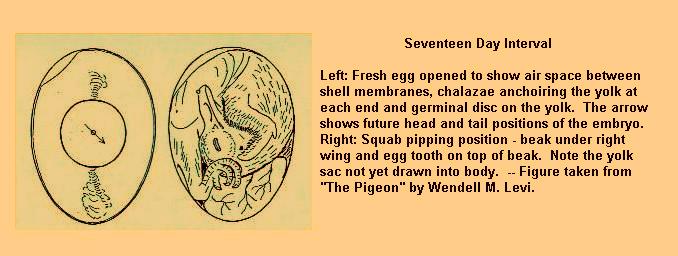Mangile's Pigeon Pages
American Pigeon Journal
August 1992, page 31.
The 'Egg Hatching' Process by Robert J. Mangile
During the time that a bird lays an egg, through the incubation period and the process of hatching, many things are going on within the shell of an egg that are generally unknown to most of us. Perhaps the final stage, (the hatching process), is of greatest interest and relative importance to the average pigeon fancier.
A detailed account of what takes place during the period of hatching should be of some interest to pigeon fanciers. Rather than falling into error or creating confusion out of personal ignorance; the following text was taken from the 1979, Readers Digest Edition of " 'BIRDS', Their Life - Their Ways - Their World" by text editor Dr. Christopher Perrins. The accompanying figure was taken from "The Pigeon" by W. M. Levi.
"There are three essential components of the egg: the yolk, the egg white or albumen and the shell. The yolk contains fat and protein which nourishes the embryo during its later stages of development, while the albumen serves to protect the yolk by acting as a cushion which absorbs jolts and jars when the egg is moved. The shell also has a protective function and is often coloured [is some species] so that it blends with its natural background.
The yolk is suspended in the albumen on two strands called the chalazae which enable the yolk to rotate and remain in one position when the egg is turned. This is important because the cells that are destined to produce the chick are formed as a small disc on the upper surface of the yolk. By allowing the yolk to rotate, the chalazae enable this disc to remain always in the same position. ........"

"One of the first organs to develop is the heart which pumps blood from the embryo through a network of blood vessels that run into the yolk. Food stored in the yolk is carried along the network to the embryo. Growth is rapid and, after a week of development in the case of the chicken (Gallus), rudiments of the adult bill, eye, limbs and even feathers are clearly seen. The bill is formed at an early stage and in almost all birds bears on its upper part a structure called an egg tooth. It is with this horny 'tooth' that the chick breaks its shell immediately prior to hatching.
An important organ that grows with the developing chick is a sac of extremely thin tissue called the allantois. This sac begins as an outgrowth of the chick's gut and eventually completely surrounds the embryo and presses against the inner walls of the shell. Without the allantois the chick would never survive because, as the chick grows, it produces waste products in the form of uric acid and carbon dioxide. These products would poison the chick if they were not removed, so the allantois functions as the chick's waste disposal unit and stores uric acid safely away and allows carbon dioxide to pass through its walls and through the egg shell to the outside.After [approximately] a month, again in the case of the chicken, the chick is ready to break out of its confining egg shell. Before hatching takes place, however, a number of important events occur. These are necessary because the environment into which the chick emerges on hatching is completely different from that inside the egg. Firstly, the chick swallows the liquid in which it has been 'swimming' and stores the water thus acquired in its body tissues. Secondly, the yolk sac with the unused remains of the yolk are pulled into the chick's body [along with portions of the allantois]. Thus the chick is provided with a food store on which it can depend during its first few days of life outside the egg. Lastly, changes occur that enable the chick to breathe air. During most of its development, the chick obtains oxygen from the gases which diffuse into its blood via the thin membrane of the allantois. But when it hatches, the chick, cut off from this supply, must use its lungs. To make the transition easier, the chick begins to breathe while it is still enclosed in its shell. As a result of evaporation, an air space forms at the blunt end of the egg and, just before hatching, the chick pierces the membranes that enclose it, and breathes in the air from this space. For a while the chick derives oxygen from both the air inside the egg, and from the blood which is pumped from the allantois, but by the time the chick hatches, its lungs are fully operational. To make it easier for the chick to hatch, the shell enclosing it is weakened by the removal of minerals. This is a neat arrangement because these very same minerals are required to make the chick's skeleton hard and able to function when the bird finally emerges."
# # #